Looking for a new way to encourage your community to shop small?
Want to raise awareness about the importance of supporting local businesses?
A cash mob is the perfect way to rally your community, create excitement, and drive sales.
This year, we sponsored three successful cash mobs to entice holiday shoppers to shop small at:
Do you live in the Boston area? Join us for our final cash mob of the season at KitchenWares on Saturday, December 3rd.
Through hosting these events, we learned the ins and outs of running a successful cash mob. Read on for an overview of how to organize and promote a cash mob of your own.
What is a cash mob?
Inspired by “flash mobs,” a cash mob occurs when a group of people assembles to make purchases in support of local businesses and the overall community.
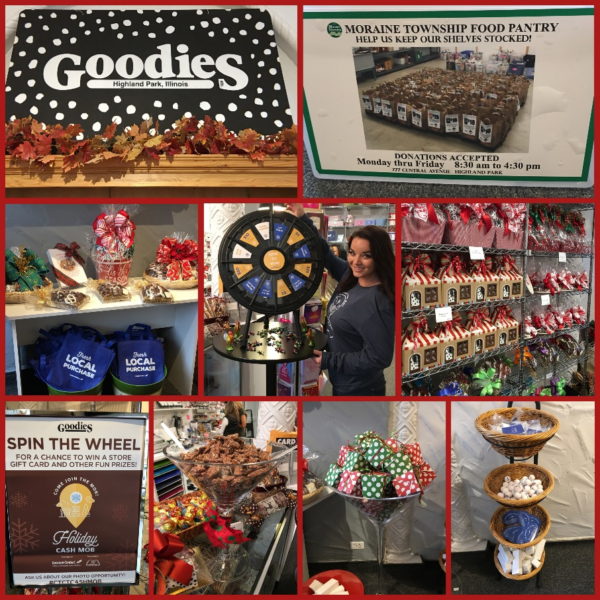
Rather than waiting for consumers to choose your business as a cash mob location, you can plan and organize your own event and entice shoppers to visit your business.
How to plan and promote a successful cash mob
Start by settling the basic event logistics: where will your event be held? At what date and time?
Then, to really draw a crowd, focus on three important steps: your cash mob incentives, local partnerships, and event promotion.
Here’s how each step supports your event:
1. Cash mob incentives
Incentivize people to come to your event by offering exclusive discounts, small prizes (such as free gift wrapping or tote bags), or an onsite activity.
During our cash mob at Greenlight Bookstore, we set up a prize wheel to give people a chance to win small $5 or $10 discounts.
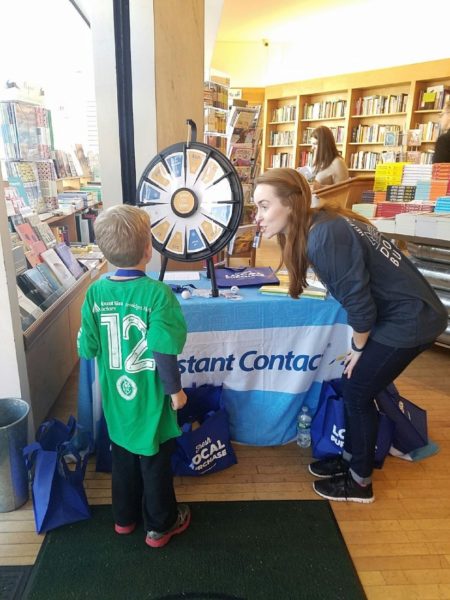
2. Local partnerships
Increase the impact of your event by making your cash mob a true community effort.
Team up with other local businesses or the Chamber of Commerce to get the word out to a larger group. You can also team up with a local nonprofit to spread goodwill and give back.
During our cash mob at Portland Saturday Market, we partnered with 200 small businesses and individual artists. We also encouraged people to support the Oregon Food Bank by bringing a canned good for donation.
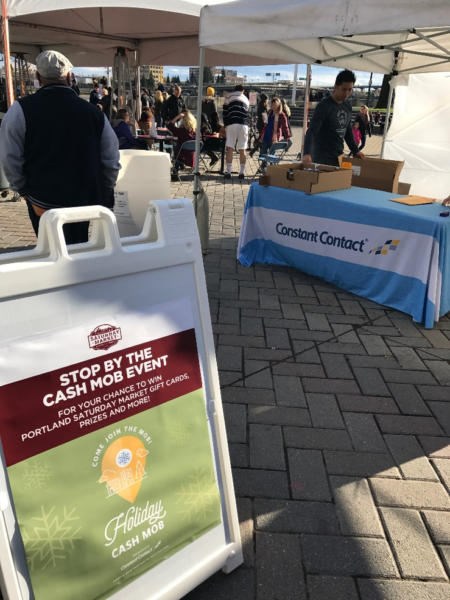
Teaming up with other local businesses and organizations allows you to combine networks and reach a larger audience. Our Portland event received more RSVPs than any of our events hosted at single businesses.
3. Event promotion
Build excitement for your event by getting the word out through email marketing and social media.
Send your email list an announcement email a couple weeks before the event. Follow up with a reminder when the event is about a week away, then a last chance email the day before the event.
Link to a registration page where your subscribers can RSVP. With Constant Contact, you can even add a block that lets people RSVP directly in your email.
If you’re on social media, be sure to promote your event there, as well. You can create a Facebook Event and post eye-catching images across your social media channels.
Here’s an example of an image we used to promote our cash mob at Greenlight Bookstore:
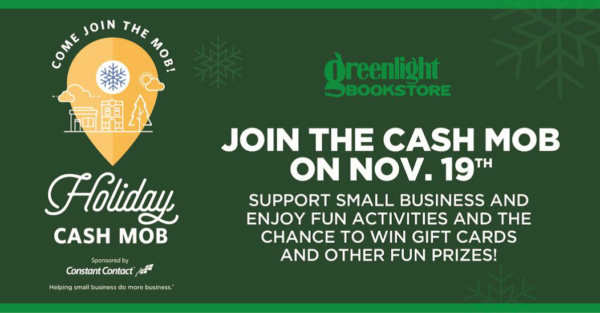
Tip: Use these tools to create effective images of your own.
During the event, make sure to snap some photos to share on social media or in your next email newsletter.
You can even take a short Facebook Live video to speak with a few event attendees and entice some last-minute stragglers to join in on the fun. Here are some tips for using Facebook Live.
Lastly, don’t underestimate setting up an attention-grabbing sign as a way to attract people who happen to be passing by. In addition to making signs with your event details, create signs with QR codes (scan-to-joins) so people can easily sign up for your email list from their mobile phones.
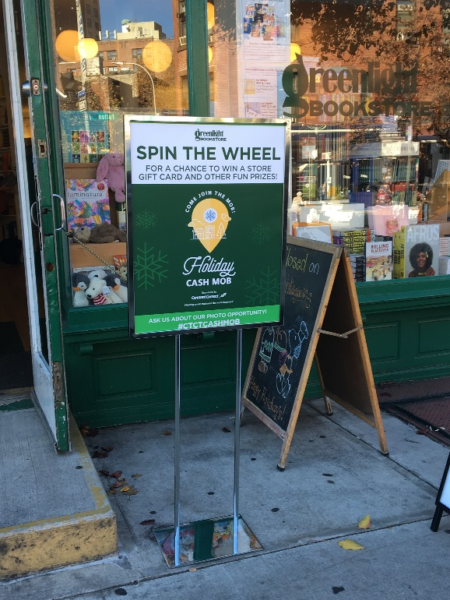
Ready to plan your cash mob?
If you’re looking to try something new at your small business, a cash mob is a great way to have some fun with your community and drive sales.
Here’s what Greenlight Bookstore owner, Jessica Stockton-Bagnulo, said about her experience:
“This was our first Cash Mob, though I know of other independent bookstores that have had great experiences with them. We had a lot of happy and excited customers, and our sales were great on the day of the Cash Mob!”
What do Wrigley Field and NASCAR vehicles and drivers have in common?
They’re both examples of opportunity branding.
The ballpark where the Chicago Cubs play got the name Wrigley Field way back in 1926 to honor the team’s owner, William Wrigley Jr. The fact that Wrigley also made the popular chewing gum elevated the ballpark to a powerful piece of outdoor opportunity branding.
Similarly, NASCAR drivers and vehicles present many opportunities to sew on logos, glue on decals, and paint the names of brands.
The lesson is that you should be as opportunistic as these people: Use every opportunity you have to feature your logo, your name, your social media channels, your phone number, or your website.
Here are some common places you can put your brand today:
1. Graphics
If you use graphics in your social media or content marketing — and you should — be sure that everything you publish is branded.
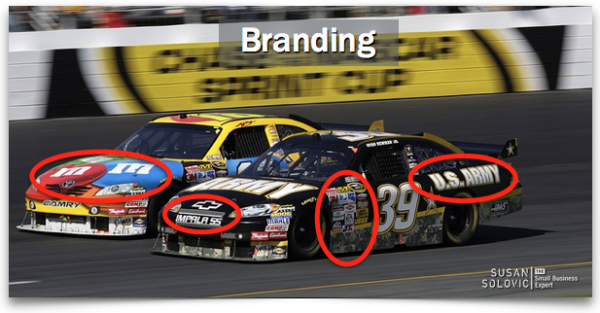
When I share this article on Facebook and Twitter, the images I create always include my logo.
2. Packaging
Bags and shipping boxes should feature your brand and perhaps even contact information.
Every package you receive from Amazon is an example of this strategy. If you can’t afford right now to print up new packaging or bags, get some nice rubber stamps made, grab a colorful inkpad and go to work.
3. Email
Your logo and social media links should be included in every email marketing message you send. Using an email service provider, like
Using an email service provider, like Constant Contact, you can easily customize an email template with your business logo, colors, social media buttons, and contact information.
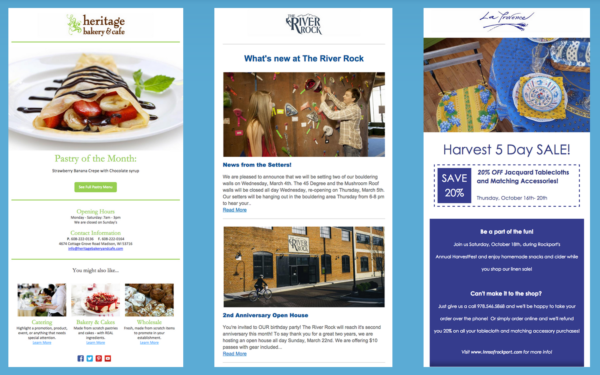
Not using Constant Contact? Try it free for 60-days.
And read this post for more tips to brand your emails like a pro.
4. Presentation materials
Whether you’re creating a PowerPoint presentation or pulling together a folder to promote your business, get your branding on everything.
Further, for items such as PowerPoint presentations, make a template so everyone on your team can create good-looking slides with your brand.
I would also include business cards, stationary, and any printed materials in this group. Drake Baer and Skye Gould have a great article over on Business Insider that breaks down business card design.
5. Vehicles
If you have company vehicles, consider a “wrap” or sign painted on your door. The Outdoor Advertising Association of America says that a wrapped vehicle can create as many as 30,000 to 70,000 impressions a day.
6. Clothing
If I say “khakis and a blue shirt,” what am I talking about? The ubiquitous “uniform” at Best Buy. Establishing a consistent look in your team is often a good idea and it can become an element in your brand identity.
7. Giveaways
Other small items should feature your branding and contact information. If you’re B2B and you serve coffee to your clients, make sure it’s in a regular or travel mug with your logo on it. Promotional items can be used wisely and benefit your business quite a lot.
Which branding opportunity are you overlooking?
Hopefully, these seven ideas have sparked new branding ideas for your business.
Want to see how better branding benefited accounting firm, Davidson & Co.? Read the success story here: How to Use Email Marketing to Build Brand Awareness.
Imagine you just finished a brand spanking new PDF for your business.
Maybe it’s a new menu. An updated catalog. A calendar of upcoming events.
Whatever it is, you wish there was an easy way to send the PDF to your email list.
Of course, you could always attach the PDF. But you want an easy way to convert the PDF to an email form.
Well, you’re in luck!
Our next-generation editor makes it easy to create an email by importing your PDF.
You can upload the PDF as an image and then edit, customize, and add interactive buttons to drive action. Your email templates will automatically be branded with the main color used in your PDF.
But first…
How could you use a PDF in your email?
- For nonprofits
Perhaps your church wants to send a longer-form article about the success of a recent youth group mission. Your team can create an interactive 3-page PDF with links to show people how to donate funds for the next mission.
Upload your PDF and offer a link to download the full interactive piece that would be too long and complex to recreate in a newsletter.
- For B2Bs
Your business delivers products and services to commercial properties. You need to send out a list with updated product and service pricing.
You can upload a PDF, make a few changes to your template, and easily keep your best customers up-to-date
- For B2Cs
Let’s say you operate a restaurant and you update your menu seasonally. Each season you could send out an update to spark interest. Show off your fall-inspired cider and pumpkin spiced cocktails and include a call-to-action button, encouraging readers to make a reservation.
Now, that we’ve looked at a few instances where using a PDF makes sense for your organization, let’s take a look at how it’s done.
Using Constant Contact’s new editor, we’re going to walk you through how to do this:
Step 1:
First select ‘Create’ to get started.
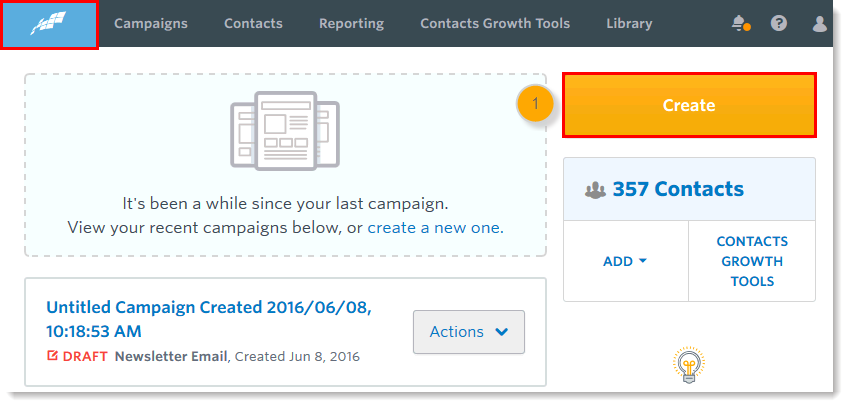
Note* The PDF Uploader will only accept PDF files of 5MB or less. It will display the first page of the PDF when uploaded to Constant Contact and generate a download button to retrieve the entire document.
Step 2:
Choose ‘Send an Email’
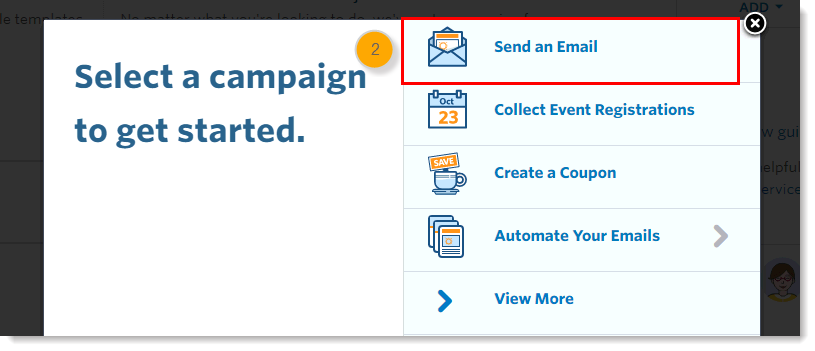
Step 3:
In the top right corner, you’ll see an option called ‘PDF to email.’ Select that to upload the PDF you want to use.
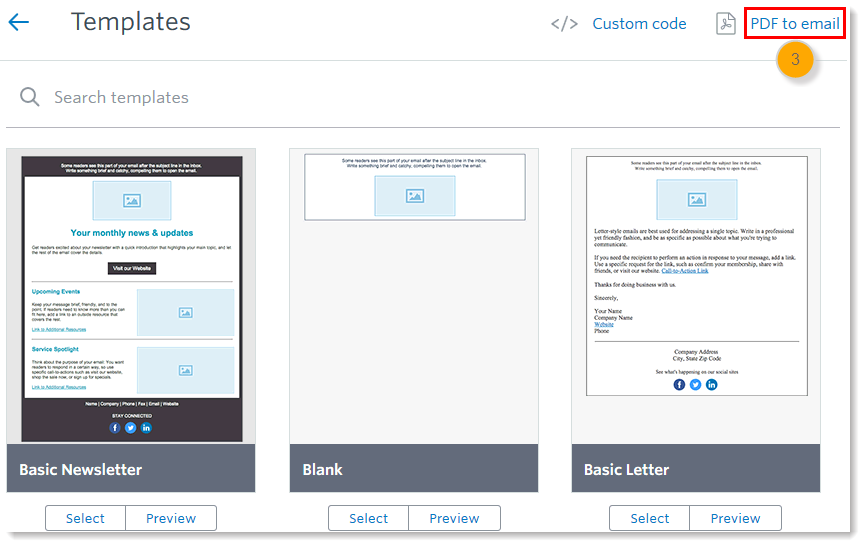
Step 4:
Choose the PDF you want to use from your library. Uploading it beforehand helps, but if you haven’t uploaded it yet you can upload it right from this screen into the library.
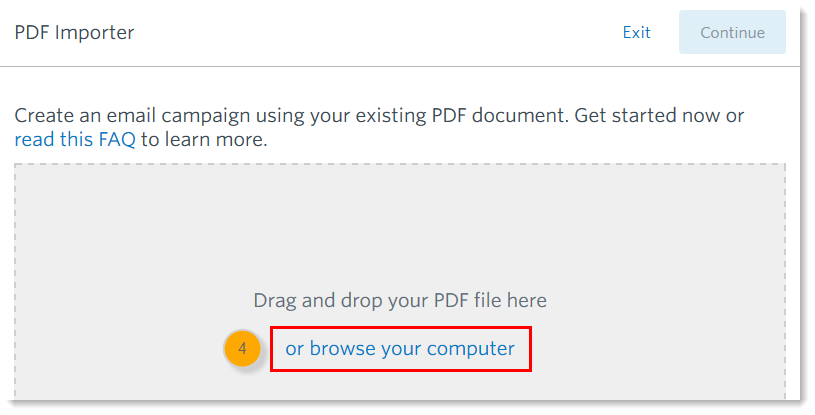
Steps 5-7:
Constant Contact will choose a template for you based upon the layout of the PDF that you uploaded. If you don’t like the way it looks, you can select a different color.
Be sure to name your new PDF template and give a little description of what it’s about for those wondering before they engage with your document.
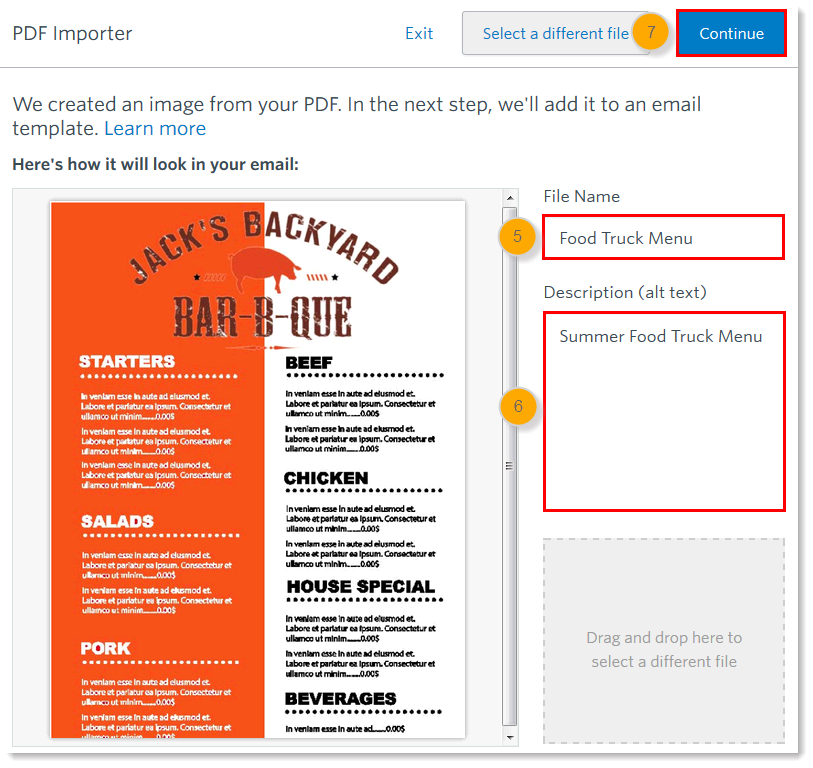
Step 8:
At this point, Constant Contact will generate an image of the first page of your PDF document and also add a Download button for folks to click to download the entire document. You can customize this button just like any call-to-action button you’ve used in the past.
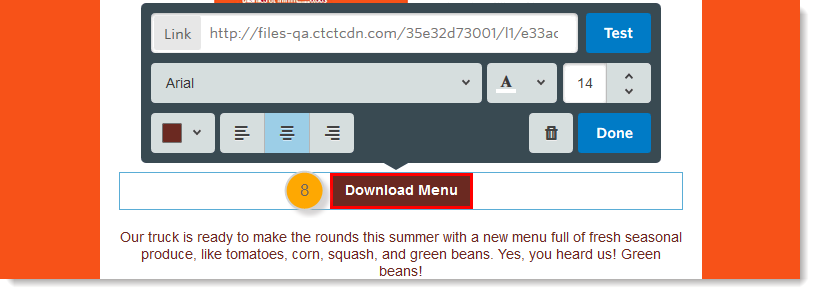
Step 9:
This is the final step. You can further customize the template, change colors, and add other blocks of content or images — whatever you need to personalize the message for your subscribers.
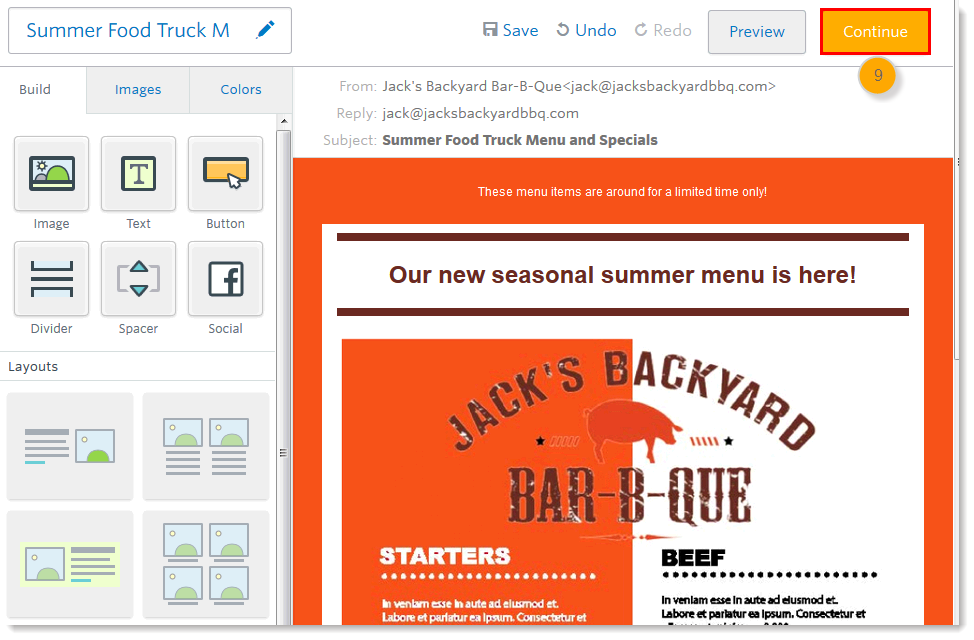
Still have questions?
You can find more information on using PDFs in your emails with these resources:
- Create an Email from a PDF Using the Next-Generation Editor
- Help Overview: Using the New-Generation Editor
- Upload a Document to the Library
Try this feature out today! Sign up for a free 60-day trial to get started.
Already have an account? Log in to get started.
